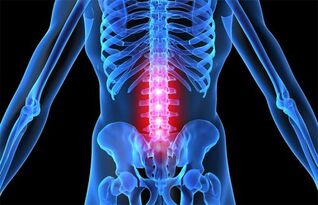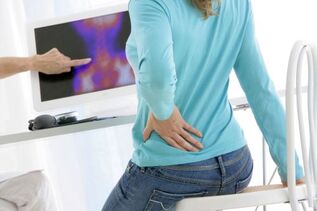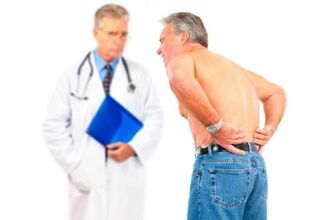A significant mass of a person falls on the lower back, and when he lifts the load, he turns, from a long static position, additional pressure is created. Excessive stress, the wrong lifestyle constantly leads to the degradation of the musculoskeletal system: the vertebrae and the discs between them, which act as shock absorbers. From here, things get trickier, and this is where the true magic of the lumbar spine comes in. Why does the joints of the spine deteriorate?

The degradation of the musculoskeletal system appears as follows: the natural shock absorber of the spine loses its elasticity, shrinks, spreads beyond its natural limits, in addition increases the pressure from other vertebrae, organs, ligaments. Let us describe those who are prone to such pathology. Osteochondrosis of the lumbar spine can be observed in individuals:
- Who the first generations suffered from similar suffering.
- Having hormonal disorders.
- Individual tendency to develop such diseases (for example, congenital structure of the spine).
- Those who neglect proper nutrition. At the table every day a person should receive a balanced diet with healthy fats, vitamins, proteins.
- Those who have sedentary work: sit for a long time or stand for a long time in one place.
- You experience heavy and heavy loads on the spine, for example: lifting weights, loaders, people while working in the garden.
- Having diseases of digestion, metabolism, pelvic organs.
- Those who were injured (they pulled their backs very hard, hit them sideways, fell, bent down).
- Reached the age of 30
- Diabetes.
If there are signs of bone osteochondrosis, which are described in the following section, then you should avoid some habits:
- slouch;
- tobacco?
- take a bent stance for a long time.
- move a little.
- do you drink alcohol?
- to sit without taking breaks from work.
- dress not for the weather, let the body cool.
Important. Any joint disorders are aggravated by the presence of excess weight. With excess weight, the load on the lower body increases and the lumbar region, overgrown with fat, massage vigorously.
Stages of the disease, the signs of
Initially, there are periodic mild pains that increase with exercise. This discomfort suggests that it is time to pay attention to the osteochondrosis of the lumbar spine. Currently, the intervertebral discs (the spinal disc is the canal through which the spinal cord and the fibrous ring around it) degrade. Further, the distance between the vertebrae is reduced, the nerves sting. The pains become severe, occupying not only the back, but also the hips, the gluteal muscles. In the third stage, the fibrous rings are destroyed, which leads to the formation of a spinal hernia, irreversible posture and pain is constantly present. The fourth stage leads to disability. The specific classification of osteochondrosis of the lumbar spine includes:
- pain?
- ischemic syndrome?
- root syndrome?
- spinal syndrome?
- ossification of excess tissues.
The sensations of pain have different degrees and severity: lumbago, for example, is called lumbago. Stable, aggravated by stress, back pain The spread to the lower parts of the body is called back pain. If back disease is not treated, the vertebrae gain too much free movement in the spine. There is a compression of the nerve roots during lifting loads and sudden actions, then the pain from the lower back goes away, but moves to other parts of the body, for which the nerve is responsible. Unconsciously, we change position, adjusting so that the pain appears less in the back, but at the same time inevitably changes the gait and flexion of the spine. All this refers to the root syndrome, which starts as an irritation and then becomes inflammatory. Signs of osteochondrosis of the lumbar spine with radical syndrome:
- The back muscles are too tired.
- reverse bending change?
- gait changes.
- swelling of the lower extremities.
- pain in one or both legs.
- severe pain?
- temporary loss of sensation in the legs.
- periodically long constipation.
- men have problems with excitement.
- menstrual abnormalities in women?
- poisoning of the body?
- blood stagnation.
You may notice that during breaks, painful sensations appear and when you do back exercises, they subside. Already at this stage it is worth looking for a doctor: chiropractor, surgeon, neurologist, injured (as the causes of osteochondrosis of the lumbar spine include trauma). If you let the disease continue, the problem will increase, completed by different partners:
- heat;
- numbness?
- sweating?
- tingling?
- chills?
- goosebumps;
- impotence?
- intestinal colic.
The back muscles lose their tone and this leads to a general loss of human motor functions. With a particularly dangerous course of radical syndrome, paralysis will occur. Ischemic syndrome is associated with rhizomes. Initially, the compression of the blood flows is periodic, but then this compression leads to convulsions. You can notice them during normal walking - you walk in pain, if you stop, it does not hurt. The main degradation occurs internally and is not visible to the naked eye - blood flow does not provide all the pelvic organs with the necessary supply. There may be pain in the buttocks, thighs and then paralysis of the gluteal muscles may occur. Spinal syndrome involves a change in the skeleton, the blood vessels themselves.
Important. The symptoms of osteochondrosis in women are inextricably linked to hormone levels, the normal characteristics of the body. The appearance of pain, inappropriate posture is affected by the use of inappropriate shoes: too hard or too soft soles. too high heel or too low heel.
Diagnoses of the stages of the disease

It can be very difficult even for a doctor to classify and name the stage of the disease on external examination. Initially, a neurologist may diagnose:
- persistent curvature of the spine?
- pain when touching.
- reduced walking?
- gluteal asymmetry?
- Michaelis diamond change.
However, the most accurate diagnosis can only be made with the results:
- computed tomography (CT). The best choice for determining the degree of development of the disease, allowing the assessment of the stage of degeneration of the spine X-rays. According to them, it is possible to detect the presence of a disease, but it is not always possible to determine the degree of damage to the nerve fibers and blood vessels.
- magnetic resonance imaging. Quite long (from half an hour to an hour), an expensive procedure, which also provides the most complete detail of what happens to the nerve roots and blood vessels.
Thus, the doctor can ultimately judge the osteochondrosis of the lumbar spine: symptoms and treatment only with the results of device research. Back pain that is not related to an intervertebral disc disorder is caused by colds, a cold kidney, a menstrual cycle, or back pain.
Important. CT and X-ray examinations are unacceptable for pregnant women. CT is not safe for: 1) children under 14 years. 2) people with iodine allergy.
Medical care
The causes of the disease, its characteristics have been examined above, now let us move on to the second point of osteochondrosis of the lumbar spine: symptoms and treatment. The more you ignore the body signals, the faster the disease will go. The farther from the beginning, the more medications and procedures should be applied. Treatment goals:
- identify, eliminate the causes of the pinching of the roots, the blood vessels of the spine.
- restore skin sensitivity.
- to prevent further development of pathology.
- start body procedures for self-healing.
- enhancing a person's muscle tone.
- restores the function of the internal organs of the small pelvis.
- return the normal course of the lumbar vertebrae.
If you feel discomfort, see your doctor. The first thing to do at the first symptoms is to pay attention: on a bed (a wide variety of orthopedic mattresses to choose from separately), a pillow (may not suit you in size or softness), sleeping position, Motor activity At home, without a doctor's examination, osteochondrosis of the lumbar spine can be treated only by resting in bed. Therefore, a visit to a doctor is mandatory. At the stage of remission and the acute phase of the disease, different drugs are taken. In the last phase, drugs are used to relieve pain, release nerves from spinal mites and eliminate inflammation. Define: - blockades, - glucocorticoids, - chondroprotectants, - muscle laxatives, - non-steroidal anti-inflammatory drugs (NSAIDs).

The last group of drugs, in addition to relieving pain, fights with excessive body temperature, edema, inflammation. Such funds may be: rectally, for internal use, injection, external. Treatment of osteochondrosis of the lumbar spine is most often started with NSAIDs:
- Diclofenac;
- Piroksikam;
- Ibuppofen;
- Himeculide;
- Hapoxy;
- Decketoprofen;
- Meloxicam?
- Aceclofenac.
The anti-inflammatory drugs in this list are various ointments, tablets, gels. Some NSAID tablets have contraindications for people with ulcers or gastritis. Muscle relaxants relieve joint stiffness and involuntary contractions of the back muscles by temporarily reducing muscle tone. This group of drugs includes tizanidine, tolperisone hydrochloride. When there is an opportunity to store the intervertebral disc, chondroprotectants are prescribed, which will serve to restore the ring. The course of taking such a group of drugs is very long - at least 1, 5 months and the results are visible only after a year. They try to avoid the appointment of glucocorticoids, as they have side effects from taking them, as this group of drugs belongs to steroid hormones. They should be taken under the supervision of the treating physician with the fulfillment of all prescriptions, as only a specialist knows how to treat low back pain. An example of such a drug is hydrocortisone. Blockages are not drugs on their own, but they are a powerful topical pain reliever. The technique is as follows: the introduction of a pain reliever (IO) or a combination of IO with a drug from the glucocorticoid group into the pain area. Blockages do not have medicinal properties, but they can be addictive, which will lead to a loss of sensitivity to these drugs. If injected frequently, the muscles around the injection may atrophy. Therefore, when acute pain is reduced by this method of treatment, the patient is prescribed drugs designed to repair damaged tissue, blood flow and help improve muscle and nerve tone. This:
- Chondroprotective agents, which have a general strengthening effect on bone tissue, normalize cartilage tissue metabolism.
- Vitamins that help restore nervousness.
- Biogenic preparations that encourage the body to heal.
- Vascular drugs that dilute the blood to improve the nutrition of internal organs.
During treatment, along with the main medication, antidepressants are prescribed. Here's how to treat lumbar osteochondrosis while reducing acute pain:
- apply external warming agents, analgesics, anti-inflammatory agents.
- do special exercises for the back.
- give a massage.
- follow a gentle lifestyle in the back.
- wear a belt corset during exercise.
Massage, exercise therapy, physiotherapy and alternative therapies.

Relatively cheap, effective methods to combat shock absorber degradation are physiotherapy exercises, massage, physiotherapy. A real massage can only be done by a medical professional, so a simple visit to the beauty salons is not suitable for patients. Each stage of the disease requires different pressure and technique. With the right treatment, the muscle spasm disappears, the muscular framework of the back is strengthened and the pain gradually disappears. Physiotherapy is applied only in the process of weakening the painful processes or when they are absent (to maintain the mobility of the vertebrae). Exercise is selected individually, based on age, condition of the person, the stage of development of the disease. The productivity of therapeutic exercises depends directly on the quality of performance and frequency: they must be done systematically. It is recommended that you rest at home, lying on your back, bending your legs, placing a small roller under your lower back. The healing process is monitored with the help of X-rays, tomographic examinations. Physiotherapy treatments are prescribed during remission and deterioration. Methods such as:
- acupuncture. An ancient method of treating pain based on stimulating acupuncture points with fine needles. The procedure relieves spasms, reduces pain, completely eliminates, reduces tissue swelling.
- ultraviolet radiation, which stimulates the body to absorb calcium.
- ampilpus, named after the corresponding device. The processing procedure is as follows: the plates of the device are attached to the back and the corresponding therapeutic current with different parameters flows through the plates.
- laser treatment. Laser rays relieve pain, heal, stop inflammation in the lumbar vertebrae
- darsonvalization. The method is designed to improve blood circulation, dilate blood vessels, stimulate nerve endings.
- Phonophoresis deals with ultrasound, stimulating blood flow to the muscular part of the dorsal region.
Each method has its own contraindications. It is more difficult with traditional medicine. Formal medicine still does not recognize that midwives know how to treat lumbar osteochondrosis. Therefore, if a friend advises you to apply compresses with burdock broth, make coniferous baths, you should consult your doctor. For anesthesia, a method like hierotherapy is used, but the leeches are hidden behind this name, so doctors advise to approach this method of treatment with caution.
Surgical problem solving
In some cases, it can no longer be done without surgery. With advanced intervertebral hernia, neurosurgeons use microdyscectomy. The function removes the damaged disk. If there are no contraindications, then doctors can perform nucleoplasty, which has many advantages:
- No cut required.
- Operation takes up to 30 minutes.
- There are no restrictions on surgeries.
Important. To maintain the mobility of the spine, strengthen the back muscles, it is recommended to do yoga, swimming, Pilates. Running produces a shock to the vertebrae, so at the first sign of back pain, jogging should be stopped.













































